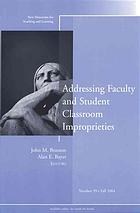Disruptive student behaviors are those which impede learning and teaching, and have the potential to escalate or spread if left unchecked. Most of these behaviors can be dealt with by creating a classroom environment that includes proactive methods of handling the problems. It is important to recognize the types of disruptive behaviors students are exhibiting early in the semester and act quickly to reduce problems.
Take a Preventative Approach
- Read up. Familiarize yourself with the university’s Code of Student Rights, Responsibilities, and Conduct.
- Start with the syllabus. Establish ground rules and communicate your expectations for appropriate student behavior including civility, attendance, tardiness, participation, turning in assignments, make up exams, re-grades, and common distractors (e.g. cell phones, laptops). Express syllabus policies in a positive not negative or punitive way, i.e. “Students are expected to…”
- Incorporate student ideas. Have your students read through your policies, point out disruptive behaviors you may have missed, and add those suggestions to your list, as is reasonable.
- Serve as a role model. Exhibit the behaviors you expect from your students. For example, if you expect your students to be on time, make sure you are on time.
- Command class attention . Use effective presentation techniques, i.e. appropriate volume, body language, and eye contact; as well as rehearsing your lectures in advance to lessen nervousness, tangents, and distracting behaviors such as searching through notes.
- Analyze your own behavior. Some disruptive behaviors could be a result of your own behavior. See Hara (2011) for suggestions on how your behavior may contribute to the situation.
Create a Constructive Learning Environment
- Encourage active learning. Methods like student-centered discussions and collaborative learning activities develop positive relationships among class members, and between faculty and students.
- Decrease anonymity and increase approachability . Learn students’ names and something about them. Meet with them individually, if possible. Get your office hours out of the office---invite students to meet you somewhere neutral, like a cafeteria or campus coffee shop.
- Seek feedback from students. Administer an informal course evaluation early in the semester or schedule a student focus group. Ask students what current topic is giving them the most difficulty and why so that they can provide constructive feedback and you can more easily address their concerns.
- Cultivate mutual respect . Let students know that you recognize them as individuals, that you are committed to their learning, that you are willing to listen carefully and respectfully, and that you expect the same from them.
- Respond in a timely manner, but stay calm. By keeping calm and addressing the behavior when it happens, you will retain credibility and earn the support of the other students. Remember your aim is not just to stop disruptive behaviors; it is also to defend the learning environment so that all students can learn.
- Personalize your comments. If a problem arises, use “I” statements and clear concise language to describe what you want and avoid arguments. If students are engaging in disruptive side-conversations, say “I would appreciate it if you would not talk while others are speaking.”
- Give students permission. Often, students feel uncomfortable confronting other students about disruptive behavior. Make it clear to students that they too are responsible for their learning environment and that each of them has the right to politely and calmly request that their classmates stop behaving in a disruptive manner. To help model how they should go about this (and to break the ice), ask them to provide examples of effective and ineffective requests.
Get an “Outside” Perspective
- Schedule a classroom observation. As someone who is busy at the front of the classroom, you may not be able to detect what is happening during class time. Colleagues and outside observers, such as staff at the CTL, can help you identify the more salient issues that may be impinging on the learning environment you have cultivated.
- Have your students evaluate classroom discussion. Either ask them to provide general feedback or have two to three students act as anonymous process observers for a day. At the end of the class session, have them report on their observations of how the discussion went, what problems they noticed, and what suggestions they have.
Manage Dominant and Attention-Seeking Behaviors
- Remind students that you want to hear from all of them. If the problem persists ask your students to suggest what might be done to give all students a chance to participate. If the attention-seeking student is consistently reporting incorrect or evidence-free information, ask the other students whether they agree or disagree.
- Change students’ responsibilities during group work . Purposely assign a quieter student the job of group reporter and/or give the dominant students jobs that require them to divert their attention elsewhere, such as recording information or writing responses to share with the class using the document camera or board.
- Speak to the student privately. Openly recognize you value the student’s enthusiasm, but remind him/her that it is your job to make sure all of the students understand the material and that you cannot do that effectively if you only hear from a few students.
Make Connections with Inattentive Students
- Use active and collaborative learning techniques. Inattention can be the result of boredom, confusion, or unwillingness to speak in public. Try breaking the class into pairs or groups to discuss a concept or problem before asking questions, or use other active learning techniques to keep students engaged. For more ideas please consult Tips for Making Lectures More Active.
- Use class time wisely. Students who habitually arrive late or leave early usually do so because they do not believe they will miss anything important. Give them a reason to rethink this strategy by scheduling activities at the beginning and/or end of class that will help them review material or prepare to learn.
- Wake up habitual chatterers (and texters!). Often, students who habitually have side conversations or play with their phones feel anonymous, as if they are invisible to you. Pause and watch to let them know you see them, or physically move to that part of the room and continue teaching. When you expect students to discuss the material publicly, purposely select one of these inattentive students, warning them ahead of time so that you can get them on your side.
- Show students the value of being prepared. Give students a quiz about the previous day’s material to remind students why preparation is important. Give students a chance speak with each other before they engage in an activity. For more ideas, please consult Tips for Getting Students to Prepare.
Manage Disruption in Online Classes
- Establish a “Code of Conduct”. Create an introductory video to address students at the beginning of the course. This video could include description of the course syllabus, other course logistics, introduction to the Learning Management System, and policies for netiquette (online class decorum). You can also provide examples of disruptive behaviors including language used in Discussion forum, email correspondences, and other communications with peers and the instructor.
- Contact disruptive students privately. Do not address online disruptions through public e-mail messages or discussion boards, unless appropriate. Write to the concerned student(s) to address the issue privately. If e-mail correspondence results in an escalated situation, ask the student(s) to have a face-to-face meeting with you at the earliest opportunity. Save all correspondence, and act quickly to deliver correspondence to a department chair or dean if matters escalate after meeting in person.
If disruptive behavior occurs in your classroom, avoid the following responses. Do not:
- React aggressively or intimidate students.
- Expel your students or force them to withdraw.
- Escalate the situation to confrontation or conflict.
- Embarrass or humiliate student(s).
- Ignore the disruption. (It may increase)
- Punish non-disruptive students.
For student behaviors that go beyond those listed in this Tip Sheet, including but not limited to aggressive and depressive behaviors, please consult the IU Indianapolis Guidelines for Dealing with Disruptive Student Conduct and the IU Indianapolis Counseling & Psychological Services (CAPS) Resources for Helping Others.
Resources
Braxton, J. M. & Bayer, A. E. (Eds.). (2004). Faculty and student classroom improprieties: New directions for teaching and learning, no. 99. San Francisco, Jossey-Bass. Retrieved from: http://onlinelibrary.wiley.com/doi/10.1002/tl.v2004:99/issuetoc
Davis, B. G. (2009). Getting underway. (p. 1-54). Tools for teaching. (2nd ed.). San Francisco: Jossey-Bass.
Hara, B. (2011). Disruptive student behavior (the professor edition). The Chronicle of Higher Education. Retrieved from: http://chronicle.com/blogs/profhacker/disruptive-student-behavior-the-professor-edition/29972.
Indiana University (2011). IU Indianapolis - Code of Student Rights, Responsibilities, and Conduct
Ko, S., & Rossen, S. (2010). Teaching Online : A Practical Guide (3rd Edition). Florence, KY: Routledge.
Nilson, L. B. (2010). Preventing and responding to classroom incivility (p.71-82). Teaching at its best: A research-based resource for college instructors. (3rd ed.). San Francisco: Jossey-Bass.
Sorcinelli, M. D. (1994). Dealing with troublesome behaviors in the classroom. In K. W. Prichard & R. M. Sawyer (Eds.) Handbook of college teaching: Theory and applications. Westport, CT: Greenwood Publishing.
Svinicki, M. & McKeachie, W. J. (2010). Dealing with student problems and problem students (there’s almost always at least one!). (p. 171-186). McKeachie's teaching tips : Strategies, research, and theory for college and university teachers. (13th ed.). Belmont, CA: Wadsworth.
Authored by Terri Tarr (March, 2006)
Revised by Sarah Lang (October, 2011)
Revised by Anusha S. Rao (November, 2015)
Related Guides
- Creating a Syllabus
- Getting Students To Prepare
- Guiding Successful Group Learning
- Making Lectures More Active
Recommended Books


Effective Classroom Management RSS from Faculty Focus
Ensuring that your classroom lessons run smoothly, establishing rules, motivating students to participate, maintaining discipline, and creating an environment in which students can succeed are all factors that contribute to effective classroom management. Turn to Faculty Focus for tips and techniques.

